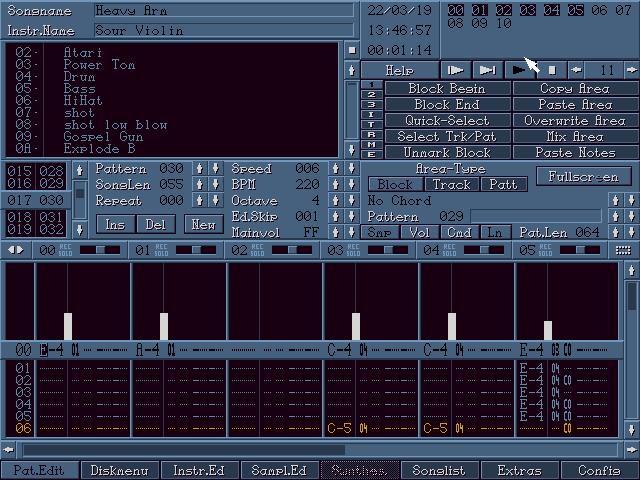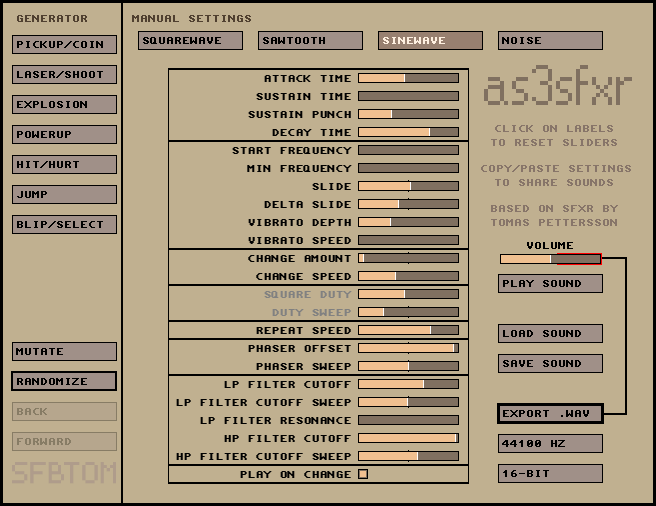History of World's End, Part 15

Crack and I had been composing with trackers since the mid 1990s, starting off with Digitrakker. Some consider trackers too unsophisticated to use in music production, but what do we care? It turns out our choice would actually serve us very well in time.
I don’t care to waste too much time reiterating what’s already been said, so you can visit our DeviantArt page to get a quick rundown on our music conversion process.
Crack’s discovery of Flod eliminated one of our biggest concerns regarding file size limitations on Flash game sites, and meant that we could have non-compressed music in World’s End, and lots of it. Can you imagine World’s End music sounding like this?!
With that settled, it was time to actually start getting this music together! We’d each composed a fair amount of tracks on our own, but as stated before, we hadn’t really stumbled upon a cohesive style yet. (If you’d like a glimpse at the style I’d been going for, please do peruse what I’ve put up on SoundCloud.)
Did I say we weren’t quite out of the woods when it came to file sizes? Even working with trackers still necessitated keeping the size of our samples at a minimal level. With this in mind, and seeking a way to merge our somewhat disparate music styles, I conjured a vague idea.
Being myself incredibly fond of industrial music (of the more percussive sort in particular), and Crack having a taste for chiptunes, I figured it’d be best to merge these ideas. Square waves and their less angular cousins are incredibly small in terms of file size, as are most drums, distorted or otherwise. No need for bloated sweeping strings or other nonsense!

Thus Crack, being far more able and/or inclined towards melody than I, would focus on melding 8-bit waveforms into the tonal aspect of our music, while I, with a far greater interest in percussion, would focus on pounding that out. Well, that was the initial idea, at least. Granted, our realms would cross over in time as the songs demanded.
Music was one thing, but what about the sounds? I’d disregarded up till now the sheer volume of sound that had to be created. Every attack and item usage and spell casting needed to have some kind of blip or blap playing alongside it. Thankfully, as “musicians”, soundcraft was something we’d become rather adept at.
I’d always been a big fan of sampling doors slamming, oven doors closing, or dropping piles of spare change for musical purposes, but for this game, it seemed a bit more might be necessary.

I manually programmed some sounds, such as all the “speech” spoken by Tevoran and others, in Renoise, but for most of the simpler synthetic noises, as3sfxr proved priceless in their generation.
Beyond that, many of the important battle sounds were produced by Crack vocally (gross mouth-noise MP3s available upon request). I even got in on the nauseating vocalizations — the vomit and licking noises are courtesy of me. You’re welcome.
What of all this? We’ve basically got a complete game, with sound and music and all the rest! Why not release it immediately, for heaven’s sake?
I have to wonder, does anyone reading this remember FGL (formerly Flash Game License)? At a certain time, it was a gateway through which most creators wishing to release Flash games had to pass if they had the faintest hope of making any money with their effort.
I did a fair share of reading about the topic, and I couldn’t believe the money that some of these Flash game creators were making! We thought that perhaps even so humble a game as World’s End might harvest but a bit of the lucre shed so freely in those days.
And yet, to make but more than two red cents in the Flash game world, one must submit oneself to the scrutiny of an extremely fickle gang of potential sponsors, and that necessitates creating promotional materials. Very well! Let’s see what we come up with, then....
2019.Apr.05
Feedback is welcome on Patreon
Thank you for your support!
